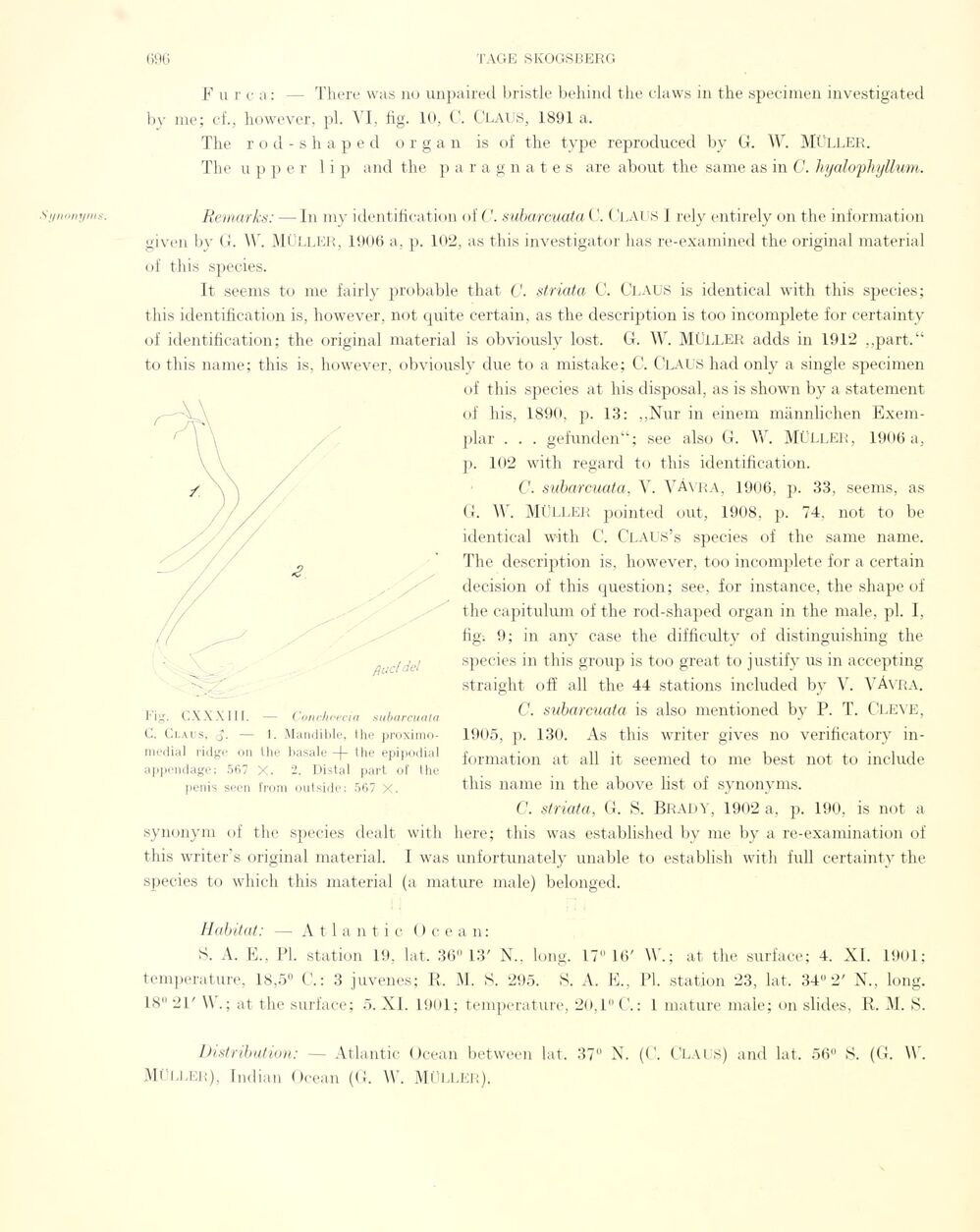
Full resolution (JPEG) - On this page / på denna sida - Sidor ...

<< prev. page << föreg. sida << >> nästa sida >> next page >>
Below is the raw OCR text
from the above scanned image.
Do you see an error? Proofread the page now!
Här nedan syns maskintolkade texten från faksimilbilden ovan.
Ser du något fel? Korrekturläs sidan nu!
This page has never been proofread. / Denna sida har aldrig korrekturlästs.
F u r ca: — There was no unpaired bristle behind the claws in the specimen investigated
by me; cf., however, pl. VI, fig. 10, C. CLAUS, 1891 a.
The rod-shaped organ is of the type reproduced by G. W. Müller.
The u p p er 1 i p and the par agn a tes are about the same as in 0. hyalophyllum.
Remarks: — In my identification of C. subarcuata C. Claus I rely entirely on the information
given by G. W. MÜLLER, 1906 a, p. 102, as this investigator has re-examined the original material
of this species.
It seems to me fairly probable that C. striata C. Claus is identical with this species;
this identification is, however, not quite certain, as the description is too incomplete for certainty
of identification; the original material is obviouslv lost. G. W. Müller adds in 1912 ,,part.“
to this name; this is, however, obviously due to a mistake; C. Claus had only a single specimen
of this species at his disposai, as is shown by a statement
of his, 1890, p. 13: „Nur in einem männlichen
Exemplar . . . gefunden“; see also G. W. Müller, 1906 a,
p. 102 with regard to this identification.
C. subarcuata, V. Yàyra, 1906, p. 33, seems, as
G. W. Müller pointed out, 1908, p. 74, not to be
identical with C. CLAUS’s species of the same name.
The description is, however, too incomplete for a certain
decision of this question; see, for instance, the shape of
the capitulum of the rod-shaped organ in the male, pl. I,
fig. 9; in any case the difficulty of distinguishing the
species in this group is too great to justify us in accepting
straight off all the 44 stations included by V. VAvra.
C. subarcuata is also mentioned by P. T. CLEVE,
1905, p. 130. As this writer gives no verificatory
information at all it seemed to me best not to include
this name in the above list of synonyms.
C. striata, G. S. Brady, 1902 a, p. 190, is not a
synonym of the species dealt with liere; this was established by me by a re-examination of
this writer’s original material. I was unfortunately unable to establish with füll certainty the
species to which this material (a mature male) belonged.
flue! del
Fig. CXXXIII. — Conchoecia subarcuata
C. Claus, <J. — 1. Mandible, the
proximo-medial ridge on the basale -ft the epipodial
äppendage; 567 X. 2. Distal part of the
penis seen from out.side: 567 X.
Habitat: — Atlantic Ocean:
S. A. E., PI. station 19. lat. 36" 13’ N., long. 17" 16’ \\. ; at the surface; 4. XI. 1901;
temperature, 18,5° C.: 3 juvenes; R. M. S. 295. S. A. E., PI. station 23, lat. 34" 2’ N., long.
18" 21’ \\.; at the surface; 5. XI. 1901; temperature, 20,1° C.: 1 mature male; on slides, R. M. S.
Distribution: — Atlantic Ocean between lat. 37" X. (C. CLAUS) and lat. 56° S. (G. \V.
Müller), Indian Ocean (G. W. Müller).
<< prev. page << föreg. sida << >> nästa sida >> next page >>